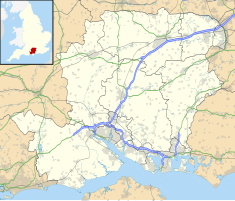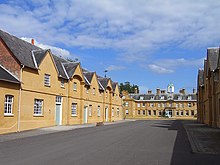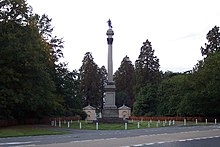
Duke of Wellington is a title in the Peerage of the United Kingdom. The name derived from Wellington in Somerset. The title was created in 1814 for Arthur Wellesley, 1st Marquess of Wellington, the Anglo-Irish military commander who is best known for leading the decisive victory with Field Marshal von Blücher over Napoleon's forces at Waterloo in Brabant. Wellesley later served twice as British prime minister.

Apsley House is the London townhouse of the Dukes of Wellington. It stands alone at Hyde Park Corner, on the south-east corner of Hyde Park, facing towards the large traffic roundabout in the centre of which stands the Wellington Arch. It is a Grade I listed building.

Lieutenant-General Arthur Richard Wellesley, 2nd Duke of Wellington,, styled Lord Douro between 1812 and 1814 and Marquess of Douro between 1814 and 1852, was a British soldier and politician. The eldest son of Arthur Wellesley, 1st Duke of Wellington, victor of Waterloo and Prime Minister, he succeeded his father in the dukedom in 1852 and held minor political office as Master of the Horse from 1853 to 1858. In 1858, he was made a Knight of the Garter.
Arthur Charles Wellesley, 4th Duke of Wellington,, styled Lord Arthur Wellesley from 1884 to 1900, was a British peer and politician, and a member of the well-known Wellesley family. He joined the military and served in the Household Division. Upon his childless brother's death in 1900, he inherited the family title and estates.

Arthur Charles Valerian Wellesley, 9th Duke of Wellington, 9th Prince of Waterloo, 10th Duke of Ciudad Rodrigo, 9th Duke of Victoria, GE, OBE, DL, styled Earl of Mornington between 1945 and 1972 and Marquess of Douro between 1972 and 2014, is a British peer and politician. He served as Conservative Member of the European Parliament for Surrey (1979–1984) and Surrey West (1984–1989) and sits as a hereditary peer in the House of Lords.

Strathfield railway station is a heritage-listed railway station located on the Main Suburban line in the Sydney suburb of Strathfield in the Municipality of Strathfield local government area of New South Wales, Australia. The station is served by Sydney Trains T1 North Shore & Western Line, T9 Northern Line and T2 Inner West & Leppington Line suburban services as well as NSW TrainLink Intercity and regional services. The station is located on the Main Northern and Main Western railway lines, forming a major junction for regional and suburban rail services. The station and associated infrastructure was added to the New South Wales State Heritage Register on 2 April 1999.

North Strathfield is a suburb in the inner-west of Sydney, in the state of New South Wales, Australia. North Strathfield is located 15 kilometres west of the Sydney central business district, in the local government area of the City of Canada Bay. Strathfield and Strathfield South are separate suburbs, to the south.

Stratfield Saye is a small village and civil parish in the Borough of Basingstoke and Deane and the English county of Hampshire. The parish includes the hamlets of West End Green, Fair Oak Green and Fair Cross.
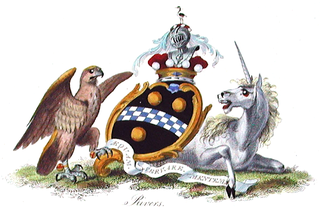
Baron Rivers was a title that was created four times in British history, twice in the Peerage of England, once in the Peerage of Great Britain and once in the Peerage of the United Kingdom.

Benjamin Dean Wyatt (1775–1852) was an English architect, part of the Wyatt family.
Heckfield is a village in Hampshire, England. It lies between Reading and Hook.

George Pitt, 1st Baron Rivers was an English diplomat, politician, military officer and peer who served as the British ambassador to Spain from 1770 to 1771.
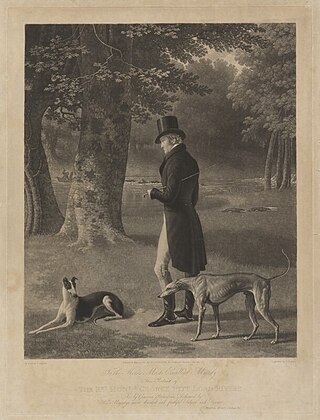
George Pitt, 2nd Baron Rivers was a French-born English politician, military officer and peer who sat in the British House of Commons from 1774 to 1790.
The Waterloo ceremony is an annual event in which the Duke of Wellington pays a symbolic rent for his residence to the reigning monarch. The ceremony takes place at Windsor Castle each year on 18 June, which is the anniversary of the Battle of Waterloo.
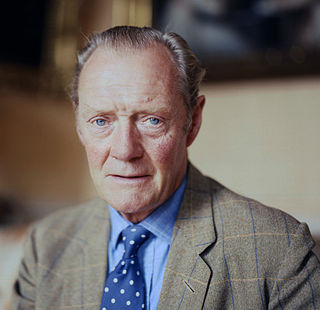
Brigadier Arthur Valerian Wellesley, 8th Duke of Wellington,, styled Marquess of Douro between 1943 and 1972, was a senior British peer and a brigadier in the British Army. His main residence was Stratfield Saye House in Hampshire.

Sir William Pitt of Old Palace Yard, Westminster, and of Hartley Wespall and Stratfield Saye, both in Hampshire, and of Iwerne Stepleton in Dorset, was an English courtier and politician who sat in the House of Commons between 1614 and 1625.
George Pitt JP was an English landowner and politician who sat in the House of Commons from 1660 to 1679.
Highfield House, also known as Highfield Park, is an early 17th-century Queen Anne style country house in Heckfield, Hampshire, England. A Grade II* listed building, it is now a hotel and venue centre.
George Pitt, of Strathfield Saye, Hampshire, was a British landowner and Tory politician who sat in the House of Commons between 1694 and 1727.

